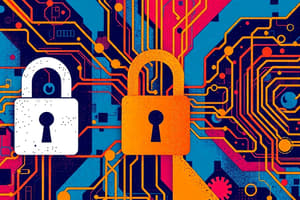Podcast
Questions and Answers
In cryptographic services, what primary security goals are achieved through authentication, integrity checks, and ensuring confidentiality?
In cryptographic services, what primary security goals are achieved through authentication, integrity checks, and ensuring confidentiality?
- Establishing user identity, maintaining data consistency, and protecting data from unauthorized access. (correct)
- Verifying user permissions, managing network traffic, and securing physical infrastructure.
- Monitoring system logs, detecting intrusion attempts, and ensuring regulatory compliance.
- Preventing unauthorized access while ensuring data accuracy and reliability.
How does hashing contribute to data integrity in cryptographic systems?
How does hashing contribute to data integrity in cryptographic systems?
- By compressing data to reduce storage space and improve transmission speed.
- By creating a unique fingerprint of the data, which changes if the data is altered. (correct)
- By verifying the source of the data through digital signatures.
- By encrypting data to prevent unauthorized viewing.
What is the purpose of using asymmetric keys for authentication?
What is the purpose of using asymmetric keys for authentication?
- To reduce the overhead of encryption and decryption processes.
- To allow verification of the sender's identity and ensure non-repudiation. (correct)
- To simplify key management.
- To speed up the encryption process.
What is the main challenge in key exchange that Diffie-Hellman and similar algorithms aim to solve?
What is the main challenge in key exchange that Diffie-Hellman and similar algorithms aim to solve?
Which of the following is a core component of the CIA triad, focusing on preventing unauthorized disclosure of information?
Which of the following is a core component of the CIA triad, focusing on preventing unauthorized disclosure of information?
In symmetric encryption, what key management issue is most prominent?
In symmetric encryption, what key management issue is most prominent?
Which security goal is primarily achieved through the use of digital certificates?
Which security goal is primarily achieved through the use of digital certificates?
How does a Certificate Authority (CA) contribute to the Public Key Infrastructure (PKI)?
How does a Certificate Authority (CA) contribute to the Public Key Infrastructure (PKI)?
What is the purpose of a Registration Authority (RA) in the context of digital certificates?
What is the purpose of a Registration Authority (RA) in the context of digital certificates?
Which of the following best describes the difference between symmetric and asymmetric encryption?
Which of the following best describes the difference between symmetric and asymmetric encryption?
Which algorithm is considered 'most secure' for integrity?
Which algorithm is considered 'most secure' for integrity?
Which key length is associated with the DES encryption algorithm?
Which key length is associated with the DES encryption algorithm?
In public key cryptography, what is the purpose of encrypting a message with the recipient's public key?
In public key cryptography, what is the purpose of encrypting a message with the recipient's public key?
Confidentiality with symmetric key is achieved with?
Confidentiality with symmetric key is achieved with?
What is the purpose of the keyed-hash message authentication code?
What is the purpose of the keyed-hash message authentication code?
What is a digital certificate mainly used for?
What is a digital certificate mainly used for?
Which of the following properties are associated with Digital Signatures?
Which of the following properties are associated with Digital Signatures?
Between PSK and RSA, which peer authentification method is considered 'Most Secure'?
Between PSK and RSA, which peer authentification method is considered 'Most Secure'?
A certificate authority (CA) has the ability to sign certificates. What is this proving?
A certificate authority (CA) has the ability to sign certificates. What is this proving?
In symmetric encryption, the same key is used for both encryption and decryption.
In symmetric encryption, the same key is used for both encryption and decryption.
Asymmetric encryption, such as RSA, utilizes the same key for encryption and decryption, simplifying key management.
Asymmetric encryption, such as RSA, utilizes the same key for encryption and decryption, simplifying key management.
Authentication provides assurance that data has not been altered in transit.
Authentication provides assurance that data has not been altered in transit.
Integrity ensures the confidentiality of data but does not confirm the sender's identity.
Integrity ensures the confidentiality of data but does not confirm the sender's identity.
Confidentiality is achieved through hashing algorithms, which scramble the data.
Confidentiality is achieved through hashing algorithms, which scramble the data.
Key exchange protocols are not necessary if both parties already possess pre-shared keys.
Key exchange protocols are not necessary if both parties already possess pre-shared keys.
Public key cryptography relies on distributing the private key to ensure secure communication.
Public key cryptography relies on distributing the private key to ensure secure communication.
In a VPN, encryption is only applied to the header of the data packet, leaving the payload unencrypted for faster processing.
In a VPN, encryption is only applied to the header of the data packet, leaving the payload unencrypted for faster processing.
Hashing algorithms are reversible, allowing the original data to be recovered from the hash value.
Hashing algorithms are reversible, allowing the original data to be recovered from the hash value.
Digital signatures provide integrity, authentication, and non-repudiation for digital communications.
Digital signatures provide integrity, authentication, and non-repudiation for digital communications.
A certificate authority (CA) is responsible for issuing digital certificates to verify the identity of individuals and organizations.
A certificate authority (CA) is responsible for issuing digital certificates to verify the identity of individuals and organizations.
Digital certificates are valid indefinitely and do not require renewal.
Digital certificates are valid indefinitely and do not require renewal.
The MD5 algorithm produces a 256-bit hash value, making it more secure than SHA-1.
The MD5 algorithm produces a 256-bit hash value, making it more secure than SHA-1.
HMAC (Keyed-Hash Message Authentication Code) uses a cryptographic key to provide both integrity and authentication of a message.
HMAC (Keyed-Hash Message Authentication Code) uses a cryptographic key to provide both integrity and authentication of a message.
In the context of cryptography, non-repudiation means that the sender of a message can deny having sent it.
In the context of cryptography, non-repudiation means that the sender of a message can deny having sent it.
Diffie-Hellman is a symmetric encryption algorithm used to securely exchange keys over a public channel.
Diffie-Hellman is a symmetric encryption algorithm used to securely exchange keys over a public channel.
Assuming Alice wants to send an encrypted message to Bob using asymmetric encryption, she would encrypt the message with her private key and Bob would decrypt it using Alice's public key.
Assuming Alice wants to send an encrypted message to Bob using asymmetric encryption, she would encrypt the message with her private key and Bob would decrypt it using Alice's public key.
The main goal of cryptography is to ensure availability of data, even if it implies sacrificing confidentiality or integrity.
The main goal of cryptography is to ensure availability of data, even if it implies sacrificing confidentiality or integrity.
PSK (Pre-Shared Key) is considered a more secure peer authentication method than RSA due to its complex key generation process.
PSK (Pre-Shared Key) is considered a more secure peer authentication method than RSA due to its complex key generation process.
A registration authority (RA) directly issues certificates to end-users, bypassing the need for a certificate authority (CA).
A registration authority (RA) directly issues certificates to end-users, bypassing the need for a certificate authority (CA).
Flashcards
Confidentiality
Confidentiality
Ensuring data is accessible only to authorized parties.
Integrity
Integrity
Guaranteeing that data remains unaltered and genuine.
Authentication
Authentication
Verifying the identity of users or devices.
Encryption
Encryption
Signup and view all the flashcards
Symmetric Encryption
Symmetric Encryption
Signup and view all the flashcards
Asymmetric Encryption
Asymmetric Encryption
Signup and view all the flashcards
Hash Algorithms
Hash Algorithms
Signup and view all the flashcards
HMAC
HMAC
Signup and view all the flashcards
PKI Framework
PKI Framework
Signup and view all the flashcards
Digital Certificate
Digital Certificate
Signup and view all the flashcards
Cryptography
Cryptography
Signup and view all the flashcards
VPN
VPN
Signup and view all the flashcards
IPsec VPN
IPsec VPN
Signup and view all the flashcards
Site-to-Site IPsec VPN
Site-to-Site IPsec VPN
Signup and view all the flashcards
SSL VPN
SSL VPN
Signup and view all the flashcards
Peer authentication Methods
Peer authentication Methods
Signup and view all the flashcards
Registration Authority
Registration Authority
Signup and view all the flashcards
Message Integrity
Message Integrity
Signup and view all the flashcards
Cryptographic Services
Cryptographic Services
Signup and view all the flashcards
Key Exchange
Key Exchange
Signup and view all the flashcards
Diffie-Hellman
Diffie-Hellman
Signup and view all the flashcards
Study Notes
- Cryptography covers symmetric vs. asymmetric encryption, authentication, integrity, confidentiality, key management & exchange, and public key cryptography.
- Authentication, Integrity, and Confidentiality are all facets of cryptographic services.
- With Authentication Alice encrypts Hash using a private key, and Bob decrypts using Alices public key
- A certificate authority signs and proves the public IP to validate authenticity.
- Encryption ensures confidentiality.
- Examples: DES, 3DES, AES, SEAL.
- Hashing is used for integrity.
- Examples: MD5, SHA.
- Authentication confirms identity.
- Examples: PSK, RSA.
- Key Exchange helps with key management;
- Example: Diffie-Hellman.
- Security of Hash Algorithms is dependent on Key Length
Studying That Suits You
Use AI to generate personalized quizzes and flashcards to suit your learning preferences.




